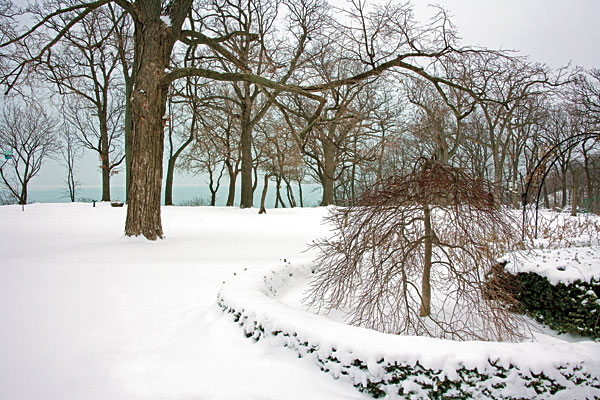
Most of the property is landscaped naturalistically. Trees dot the lawn leading down to Lake Michigan.
On a large property, the grand views take center stage—especially if those views are of Lake Michigan. A side garden that can’t be seen from inside the house is rarely a top priority. Easily overlooked, such spaces can become little more than passageways to the main event.
But a garden apart can also be a secret oasis, a space with its own distinct style and spirit. That was the hope of one North Shore homeowner who decided to transform a previously neglected portion of her property into a place that would feel special no matter what the season.
“She loves French gardens,” says Douglas Hoerr of Hoerr Schaudt Landscape Architects, who designed the space. “She wanted it to have a magical feeling when she walked in, that dreamy quality you see in a Monet landscape.”
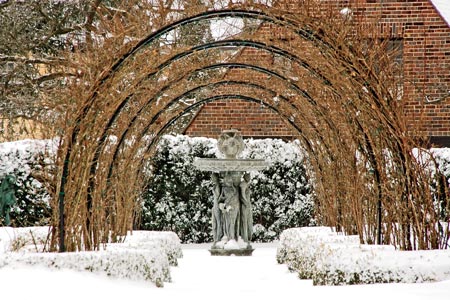
Architectural details such as curved steel arbors and an antique fountain enhance the
garden’s classical look.
Potential challenges included the garden’s irregular shape and its less-than-prime location between the house and the property next door. Visible from the front driveway as well as the backyard pool area, it had to be visually appealing from both ends and provide a smooth transition between those two spaces.
The garden’s separateness turned out to be a plus. “It was designed to be experienced in person,” Hoerr says. “It didn’t have to relate to the rest of the house and the grounds, which gave us the liberty to do something more theatrical.” While most of the broad-lawned property was landscaped naturalistically, the side garden could be more formal, with crisp architectural lines and the feel of a self-contained room.
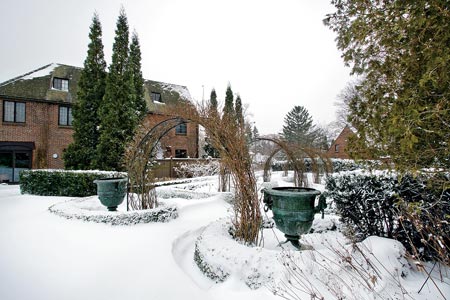
Running alongside the house, the garden acts as a transition between the backyard pool
area and the front drive.
“We decided early on to make it interesting within that space, almost like a city garden,” Hoerr says. While the client’s wish to use the space for summer entertaining determined the overall layout, the garden’s elegant structure holds up year-round.
To establish a strong identity for the area, Hoerr laid out a central axis, delineated by curved lines of boxwoods. For summer dinner parties, tables are set in circular spaces where the hedges widen; illumination comes from lights in the steel arbors.
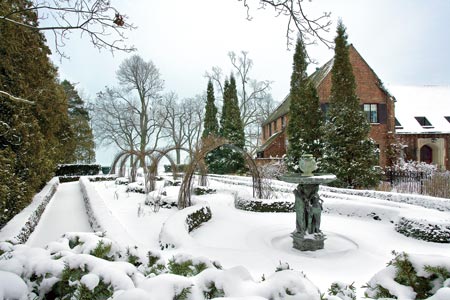
“Every garden we design in this region is designed for winter first,” says Douglas Hoerr,
the landscape designer.
Come winter, those undulating hedges and curved arbors provide a framework that stands out in a white snowscape. “Every garden we design in this region is designed for winter first,” Hoerr says. “We want the structure to be pleasing to the eye. When a lot is bare, you see it very honestly.” The initial design decisions focused on the underlying architecture of the space: the lines of the hedges, the shapes of branches, the patterns formed by fences and walkways. Flower beds were planted with colorful perennials that create a cheerful, welcoming atmosphere in warm weather, but the garden’s core composition comes to the forefront once the flowers and leaves have faded.
Vertical elements were incorporated as a counterpoint to the horizontal lines of the hedges. An antique fountain, purchased from an auction house in Atlanta, was added as a focal point near the driveway. Spires of arborvitae help block views of the house next door; their structural similarity to cypresses enhances the garden’s European sensibility.
Decorative elements also were chosen to fit the formal French concept, from black ornamental iron fencing along one side to dramatic urns that flank the entrance overlooking the pool. “Everything works together stylistically,” Hoerr says. “All the pieces were chosen to add support to the larger concept.” To assure a timeless quality, plants were selected for their hardiness and durability; the goal was to create a space that will look the same in 20 or even 50 years.
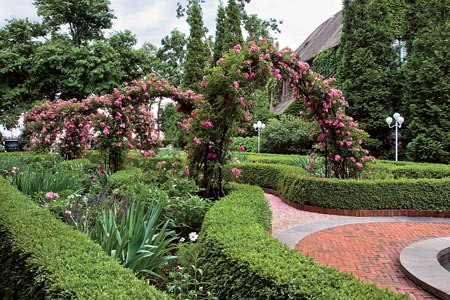
In the summer, the homeowner hosts dinner parties amid the rose-covered arbors, which
retain their elegance even without flowers.
While the garden flourishes in the summer, when pink Zephirine Drouhin roses cover the arbors and perennials such as dahlias and artemisias fill the beds, winter brings out another side. The winding paths become a place for quiet contemplation. The fountain’s sculptural qualities stand out against a monochromatic landscape, while tangled vines soften the stark lines of the arbors. “We wanted the garden to have a strong winter presence,” Hoerr says. “It holds together even without flowers.”
This European-inspired garden room proves that you don’t need a great view, or a great location, or one-of-a-kind plantings to make a statement. With a clear vision and a strong framework, a French sensibility can be transplanted into a Midwestern landscape, creating its own self-contained world. The homeowner calls it the Magic Garden—proof that it embodies all the qualities she had hoped for.
RESOURCES: HOERR-SCHAUDT LANDSCAPE ARCHITECTS
312-492-6501, HOERRSCHAUDT.COM
Photography: Linda Oyama Bryan


